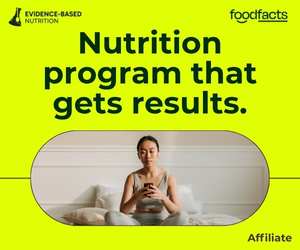
Can freezing white bread make it healthier? Here’s what you need to know





Coral Red: Mostly False
Orange: Misleading
Yellow: Mostly True
Green: True
Learn more about our fact-checking policies
On the 22nd April 2024, This Morning posted a clip of Emily English (@emthenutritionist) discussing how freezing bread can convert the starch into resistant starch. She claimed this could help “slow down your blood sugar spikes, it helps to reduce the glycemic response and it also feeds your gut microbiome”. She also stated, “You instantly improve the nutritional value of it by freezing your food.”
Not only that, it can also feed your gut microbiome, making it a simple and effective food hack. While it may not work for every starchy food, it’s a great way to add a little extra nutrition to your daily toast!
This claim has caused a lot of confusion online, so we dug into the facts to help clear things up.

Question viral content: If something seems too outrageous or extreme, it may be misleading or false.
Claim 1: Freezing bread slows down your blood sugar spikes and helps to reduce the glycemic response
Verdict: It’s true!
It’s nice to find a food hack online that really works, and this is one of them!
Research supports the claim, showing that freezing white bread overnight and then toasting it can lower its glycemic index (GI), which means it causes a slower and more gradual rise in blood sugar levels.
A 2008 study published in the European Journal of Clinical Nutrition found that freezing bread and toasting white bread significantly lowered the blood sugar response compared to fresh white bread. They found three different methods favourably altered participants’ glucose responses to the bread: freezing and defrosting, toasting from fresh, and toasting following freezing and defrosting.
More recent research backs this up. A 2017 study found that altering the temperature of bread increased resistant starch content, which is key to lowering blood sugar levels. In 2023, a study published in the journal Novelty in Clinical Medicine showed that participants who ate frozen and reheated bread had a lower glycemic response than those who ate fresh bread.
So, why does this happen?
When you put your bread in the freezer overnight, the starch will break down, and more retrograded starch is formed, which is a type of resistant starch. This is where the carbohydrate chains in the starch realign themselves, which increases the proportion of resistant starch in that food. This starch acts more like a fibre because isn’t broken down as easily by your digestive enzymes, so it’s absorbed more slowly, resulting in a more gradual rise in blood sugar.
Cooling or changing the temperature of other starchy foods such as rice, bread, and potatoes can also cause starch retrogradation to occur in these foods.
While the effect is not super significant (like the study showing 120 mg/dL for frozen bread vs. 132 mg/dL for fresh bread), it’s still a useful strategy for managing blood sugar. People with blood glucose issues should monitor their levels and follow their doctor’s recommendations for how often to check them. The impact may also vary depending on the type of bread.
Claim 2: Freezing bread feeds your gut microbiome
Verdict: True!
Resistant starch isn’t just beneficial for blood sugar control; it’s also a type of prebiotic, meaning it helps to feed the good bacteria in your gut.
When you consume resistant starch, it reaches the large intestine undigested, where it becomes food for your gut bacteria. This process produces beneficial compounds, such as short-chain fatty acids, which support gut health and health beyond your gut. For example, it may play a role in your inflammatory responses and benefit the immune system.
So, by freezing and reheating your bread, you’re not only lowering its glycemic index but also feeding your gut microbiome!
Does this happen with every type of starch?
The effect of freezing and reheating starches can vary depending on the food. While studies show that freezing bread helps, research hasn’t found the same to be consistently true for other starchy foods like rice.
For instance, a 2015 study on white rice showed that cooling and reheating the rice lowered glycemic response compared with freshly cooked white rice. However, a more recent study in 2021 found no significant difference in glycemic response between fresh and cooled rice.
Therefore, not all starchy foods will behave the same way. Freezing can improve resistant starch content, but the impact on glycemic response can vary based on the food’s composition.
Who can it help?
For most people, blood sugar spikes after eating are a normal physiological response provided they rise and fall within the normal range, and if you eat a generally balanced diet, there’s no need to worry about trying to control every spike. However, for individuals with insulin resistance, pre-diabetes, or diabetes, managing blood sugar levels and spikes is important to prevent complications.
For those managing their blood sugar, freezing starchy foods like bread, potatoes, or rice could be a useful strategy to help prevent large spikes in glucose.
But it’s not just about blood sugar! The extra-resistant starch can improve gut health, support weight management by improving satiety, and even reduce calorie absorption since resistant starch isn’t fully digested.
Resistant starch may improve satiety and reduce calorie absorption, but it's not a guaranteed or significant effect for everyone. The impact on weight management or calorie absorption is relatively minor, so adding a note to manage expectations would make the claim more balanced overall.
Other benefits
Beyond the health perks, freezing bread has practical advantages too:
- Food waste reduction: Freezing bread extends its shelf life, allowing you to store extra loaves or reduced-price bread without it going stale.
- Longer freshness: If you can’t get through a loaf before it goes bad, freezing keeps it fresher for longer.
- Improved satiety: Foods rich in resistant starch help keep you fuller for longer, which can assist with appetite control and weight management.
Sources
Burton et al. The impact of freezing and toasting on the glycaemic response of white bread. https://pubmed.ncbi.nlm.nih.gov/17426743/.



Foodfacts.org is an independent non-profit fact-checking platform dedicated to exposing misinformation in the food industry. We provide transparent, science-based insights on nutrition, health, and environmental impacts, empowering consumers to make informed choices for a healthier society and planet.
🛡️ Stand Against Nutrition Misinformation
Misinformation is a growing threat to our health and planet. At FoodFacts.org, we're dedicated to exposing the truth behind misleading food narratives. But we can't do it without your support.
Your monthly donation can:
✅ Combat viral diet myths and corporate spin
✅ Support our team of dedicated fact-checkers and educators
✅ Keep our myth-busting platforms running

Was this article helpful?
















.svg)
